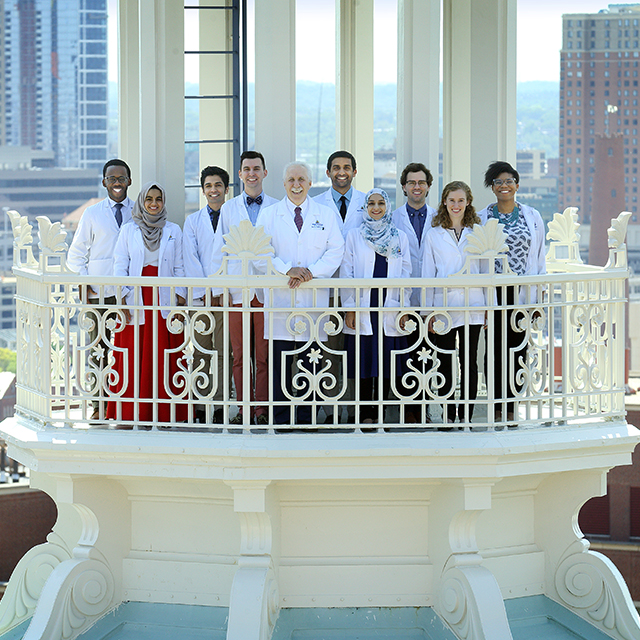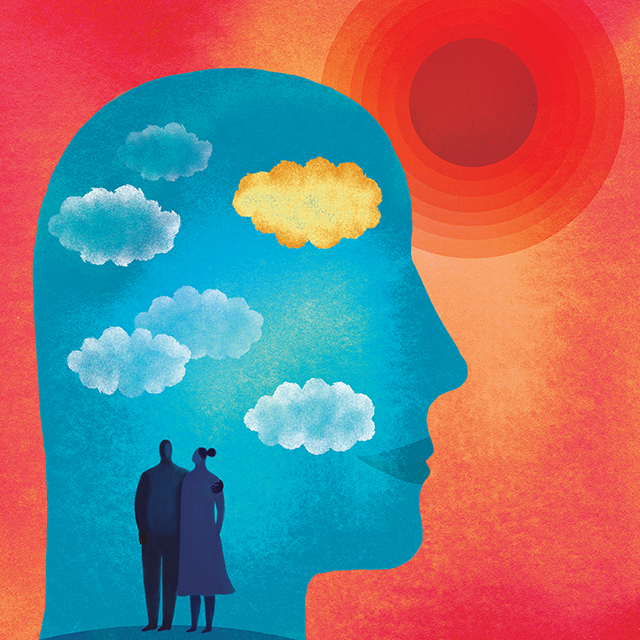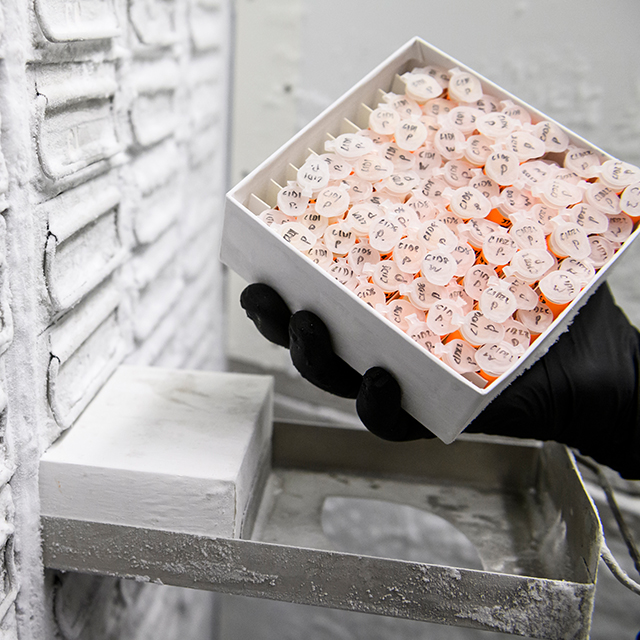By spring 2020, the pandemic had arrived in full force at The Johns Hopkins Hospital’s medical intensive care unit (MICU). Every available bed was filled with gravely ill patients, nearly all intubated and unable to communicate. No visitors were allowed — not even spouses. The patients themselves couldn’t even get a good look at their caregivers, who were all wearing masks.
Physicians and nurses toiled on the edge of burnout, trying as best they could to bury their own fears about bringing a potentially deadly disease home to loved ones.
Everything was in short supply, even protective gear. That’s why chaplains were kept away from bedsides as well. Chaplain Elizabeth Tracey pitched in during those days via virtual connections. “It’s not a satisfying way to work,” she says in a tone so understated that it comes across like a shout from the rooftops.
As one virtual session with a patient drew to a close, Tracey sought out an extra moment from physician Brian Garibaldi, director of the biocontainment unit. She was worried that long hours at work in this uncertain pandemic environment might be taking an emotional toll on him and his colleagues. The two had worked together enough through the years that she could approach him out of friendship.
“Brian, how’s it really going for you?” Tracey asked.
“Elizabeth. It’s terrible,” Garibaldi replied. “All my patients are prone in bed. They’re all intubated and sedated. I have no idea who they are.”
Patients who can’t speak aren’t a new phenomenon in units like the MICU, of course. But now they were the only patients Garibaldi saw. With no family members allowed to visit, he often had nowhere to turn to get a sense of who these patients were as individuals.
“Nobody’s telling me their stories,” he lamented.
In that moment, something clicked in Tracey’s head. She wears a second hat at Johns Hopkins, as a journalist in the Department of Marketing and Communications who puts together radio segments distributed through the Johns Hopkins Health Newsfeed. Her stories about scientific and treatment advances air on hundreds of stations across the country. Suddenly, she saw herself donning both hats at once — the chaplain and the storyteller joining forces in pursuit of a new mission.
“I just blurted it out, then and there,” she recalls. “I said, ‘Brian, I think I can help here.’”
Shared Humanity
Tracey’s idea was to provide MICU physicians and other members of the care team with short audio files based on interviews she would conduct with family members of these patients. She started out in informal fashion, with a handful of let’s-try-it-out Q-and-A sessions, which she dubbed: This Is My Story (TIMS).
As the number of TIMS files multiplied into dozens, and then hundreds, the initiative grew by necessity out of its one-woman-show phase and into one supported by a team with wide-ranging expertise.
Fellow chaplain Jason Wilson came on board early, bringing a wealth of research-design experience from his day job as an institutional review board analyst with the National Institutes of Health. Both Ty Crowe, who directs chaplaincy operations at the hospital, and Paula Teague, who does so at the Johns Hopkins Health System level, advocated on the administrative front, helping TIMS navigate past bureaucratic obstacles. Pastoral education students came on board and conducted interviews. Medical students stepped in to edit files, and later became interviewers.
The initiative soon expanded beyond its COVID-19 origins in the MICU into other units at the hospital and other facilities in the Johns Hopkins Health System, with help from a pair of grants from the John Conley Foundation for Ethics and Philosophy in Medicine.
The Digital Media Group in the Office of Marketing and Communications stepped in to help edit audio files, arrange space for those files on secure servers and to structure a way to integrate them into the electronic health record. Translators were called in to help with patients who spoke Spanish, Mandarin, Arabic and other languages. Physicians, too, joined the team, taking on co-author roles as studies were launched to gauge program results.
As word of the success of the TIMS program spread, hospitals in other parts of the country got in touch, looking for advice about starting their own versions of This Is My Story. “From very early on,” Wilson says, “we’ve been focused on these questions of scalability and growth. Is this something that can be repeated in other units and at other places? Can we demonstrate that it really has value?”
The sessions in those two-minute audio files — which doctors, nurses and others on a patient’s medical team can listen to through a link attached to a note appended in the medical file — tend toward human interest insights. The material is as likely to touch on cherished pets, beloved grandchildren and interesting hobbies as it is on the resume-style summaries of career paths and academic accomplishments. That’s by design, of course. The goal is to get personal, providing caregivers at work in high-speed, high-tech environments a briefing focused on the idiosyncratic humanity of any given patient.
Barbara Johnson is the sister of one such patient. She worked with Tracey to make a TIMS file about Beverly, who would eventually die from COVID-19. Barbara mentions the number of siblings in the family and a few other such details, but what jumps out is this: “Everyone who knows my sister talks about how sweet she is.” And this: “She is very short, but she could hit the softball out of the park.” You can hear Johnson struggling to hold back tears while trying to give caregivers a sense for the full humanity of her gravely ill sister.
“Everywhere you turn in medicine, it’s a human story, right?” Tracey says. “The patients are human. The doctors are human. The nurses are human. Chaplains are human. TIMS is all about making sure that shared humanity is part of our awareness as we practice.”
TIMS fits in with a broader “humanistic” approach to medicine that stresses the importance of relationships and communication — an approach that harkens back to physician William Osler in the founding days of medicine at Johns Hopkins. Among the Osler aphorisms that are still widely bandied about: “It is much more important to know what sort of a patient has a disease than what sort of disease a patient has.” And: “The good physician treats the disease; the great physician treats the patient who has the disease.”
Otolaryngologist Charles Cummings, who helped secure the Conley Foundation funding for TIMS, cites these Oslerisms in talking about the project.
“There has been such a profound encroachment into the patient-physician relationship since Osler’s time,” he says, ticking off an array of the modern technologies, insurance protocols and regulatory mandates. “It’s so easy now to just see the patient more as a bunch of numbers than as a full human being. What TIMS is about is helping us get back to the proper essence of medicine, understanding again that it’s essential to get to know the patient if we’re going to be able to help that patient as best we can.”
Pulmonologist Charles Wiener still does rounds in the MICU, even while serving as president of Johns Hopkins Medicine International. He, too, regards TIMS as a valuable tool in facilitating patient- and family-centered care.
“Simple little things, even just knowing the name of a dog the patient loves, can help family members feel like you’ve made an extra effort to get to know their loved one,” he says. “That trust is a building block” that can help both sides establish camaraderie and find common emotional ground while navigating complex treatment decisions and approaching heartbreaking questions about end-of-life care.
“I’m not sure of the right word, when you’re adding depth and context like this,” he says. “Maybe arborization? Think about what happens when leaves appear on a bare tree, the way it becomes something so much greater and more magnificent. That’s what the audio files can do, fill out that picture of patients as people.”
‘It Changed the Way We Looked at the Patient’
In the early days of TIMS, Tracey found that several Johns Hopkins physicians she contacted for advice were skeptical. How much useful information could a short audio file really contain? Would physicians and nurses working amid pandemic pandemonium actually make the time to pay mindful attention?
When Tracey asked intensivist Dale Needham to play along, he agreed, but reluctantly.
“I’m not sure this is going to work out the way you want it to,” Tracey recalls him saying. “But because I know your work, I’ll try it.”
Needham’s next shift on the MICU began on a Monday morning. That afternoon, he called Tracey: “Could you please do this for all my patients?” In short order, Tracey reports, Needham became a key advocate for expanding TIMS in the MICU and beyond.
Wiener, too, recalls his introduction to the program as an eye-opening experience. When Tracey let him know that she had prepared an audio file for one of his patients, he set aside hallway time during rounds to play the recording for the entire care team before going into the patient’s room.
“I don’t remember all the medical details of the case anymore,” he says, “but I do remember the impact that recording had. The patient’s daughter had so many fascinating things to say about her mother’s life. The entire team was captivated. It really changed the way we looked at that patient.”
Starting out, the opportunity for families to participate in TIMS was limited to patients whose conditions or treatment protocols left them unable to speak and whose prognosis indicated a likely hospital stay of more than three days. The TIMS team now also conducts interviews with patients who are able to speak for themselves, lessening the need for patients and caregivers to repeat the same introductory exchanges with every shift change and new specialist.
Tracey estimates the number of interviews conducted to date at more than 400, and notes that it is rare for a patient or family to decline to participate. “They say yes almost every time, and they love doing it,” Tracey says. “It makes them feel like they’re impacting the care of a loved one in a positive way.”
The current scripted interview template that Tracey developed focuses on four questions: How does the patient want to be addressed? What brings the patient joy? What does the medical team really need to know about this person in order to give the best possible care? What sustains the patient in times of trouble?
Medical student Carolyn Im came to the TIMS team with a background in storytelling from the Center for Documentary Studies at Duke University. She was surprised at how quickly patients and family members were willing to open up. With interview experience, Im says she’s gotten better at seeing when she needs to nudge her subjects to expand on this comment or explain what they mean by another.
“Taking the time to listen to someone can make them feel heard and understood,” she says. “It can also help practitioners to provide more intentional and well-informed care. One thing I’ve learned in this is that to be a good doctor, I need to learn to be a good listener.”
Currently, audios are edited using a process that can take about an hour or more. Tracey is working with Johns Hopkins information technology experts to develop an app they’ve dubbed “TIMSe,” with the small e standing for electronic. The app would employ artificial intelligence techniques to automate the editing process, allowing even inexperienced editors to get to a finished product with relative ease.
Boosting Morale for Caregivers
The first journal piece on TIMS, in the July 2021 Journal of Religion and Health, laid out a handful of case anecdotes accompanied by commentary from Johns Hopkins physicians, nurses and other caregivers [“The TIMS Difference,” p. 31]. A second paper describing what went into expanding TIMS has been accepted by the same publication.
Recently submitted for publication is a third paper — a more rigorous survey that confirmed the initial and anecdotal signs that TIMS was getting an enthusiastic reception.
Tracey notes that of the nearly 100 Johns Hopkins caregivers surveyed, 98% describe TIMS as “useful” and “appropriate,” with 99% saying it improves interactions with family members. Three in four say it boosted their empathy for patients. Nearly two in three say it reduced their own levels of clinical distress. Interestingly, three in four said that access to TIMS files actually saves them time that would otherwise be spent talking with family members about the personal details of patients’ lives.
“Instead of going in there and having to sort of start from zero, you get to go in and meet them right away with that human touch,” Tracey says. The files can also help facilitate visits from various care teams working in different shifts and specialties — improving the hospital care experience for both caregivers and families, since they don’t all have to go over the same ground, time and again. Survey results like these leave Tracey wondering about other types of medical encounters where TIMS might prove useful.
“Imagine you’re getting ready to see a patient in a telemedicine appointment,” Tracey says, “and you can open an audio file and listen to that patient answering those four questions in his or her own voice. Maybe the patient talks about a Labrador retriever and you can get on there and start right in talking about how much you love Labs. What a great point of entry, right? It’s not just blood tests and EKG results anymore.”
Expanded access to TIMS may also prove to be a morale booster for members of the health care team, says Cummings. Nurses and physicians come into the field with noble intentions centered around caring for people in need, he notes. “But a time comes during their training or later, in practice, when they get a little jaded and that idealism begins to leach away. It’s critically important that we look for ways to reaccentuate the human side of things and reawaken that feeling that this work really is a calling,” he says.
Might TIMS also improve patient outcomes? That will be difficult — and perhaps impossible — to measure accurately, but Cummings puts that possibility on the table as well.
“These patients may be intubated and sedated, but they’re still able to hear and be aware of the outside environment,” he says. “If the care team can approach them as a true individual, that alone might make a contribution by instilling hope. Patients will think, ‘These people know who I am. They’re trying to help me.’”
Dale Needham may have been skeptical at first about TIMS, but he now sees the program as a way for Johns Hopkins to lead the way as an innovator in patient care. This is “an academic medical center, [and] we need to be a learning lab,” he says. “We need to invent, try out and then disseminate ways to improve care. And I think this is a novel approach that I hope will catch on.”
Barbara Johnson, the woman who had so many heartfelt things to say about her late sister on a TIMS recording, would agree.
“Every hospital should do this for everybody, not just COVID-19 people,” she says. “You know, I think what is happening at Johns Hopkins is at the leading edge of changing the human piece in medicine, and it is long overdue.”


